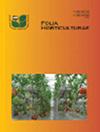褪黑素处理减少“华盛顿”脐橙果实冷藏过程中的冷害
IF 2.2
4区 农林科学
Q2 HORTICULTURE
引用次数: 2
摘要
摘要冷藏是提高柑橘果实贮藏和处理效率的一种手段,但柑橘果实易受到冷害。抗氧化酶是“华盛顿”橙子在冷藏期间抗CI的抗氧化防御系统的一部分,它控制着储存/处理效率。在这项研究中,褪黑素(ME)被用于水果以减少冷损伤。评估ME影响的行动;果实在商业成熟期从树上摘下来,分成大小和颜色一致的两组。然后在20±1℃条件下,分别在0 mmol、10 mmol、100 mmol或1000 mmol的ME溶液中浸泡20 min。处理后的果实分别于2019和2020两季在4±1℃、95±1% RH条件下保存4周。贮存期结束前,每周对贮藏果实的物理和化学特性进行测定。结果表明,在1000 μM ME中浸泡可使果皮的ci指数和水分损失率降到最低,并能在冷藏过程中保持果皮颜色(h°)。另一方面,同样的处理使可溶性固形物含量(SSC%)略有变化,维持了抗坏血酸(AA)含量和总酸度(TA%)的稳定性,提高了抗坏血酸过氧化物酶(APX)、过氧化氢酶(CAT)和超氧化酶歧化酶(SOD)等抗氧化酶活性(AEAs),降低了冷藏过程中丙二醛(MDA)和离子泄漏(IL)的速率。此外,它最大限度地减少了过氧化氢(H2O2)和超氧阴离子(O2•−)的产生,并在抗氧化能力方面表现出明显的效果。总体而言,1000 μM ME处理对柑橘果实的耐受性更强。本文章由计算机程序翻译,如有差异,请以英文原文为准。
Reduction of chilling injury of ‘Washington’ navel orange fruits by melatonin treatments during cold storage
Abstract Cold storage is used to improve the efficiency of storage and handling of orange fruits, but the fruits are exposed to chilling injury (CI). Antioxidant enzymes are part of the antioxidant defence system against CI of ‘Washington’ oranges during cold storage, which controls storage/handling efficiency. In this study, melatonin (ME) was used on fruits to reduce cold damage. To assess the action of ME influences; fruits were picked from the tree at the commercial maturity stage and divided into two groups that were uniform in size and colour. Then, they were immersed in ME solution at 0 mmol, 10 mmol, 100 mmol or 1,000 mmol for 20 min at 20 ± 1 °C. The treated fruits were stored at 4 ± 1 °C and 95 ± 1% RH for 4 weeks during 2019 and 2020 seasons. The physical and chemical characteristics of the stored fruits were measured every week up to the end of the storage period. Results indicated that immersing fruits in 1,000 μM ME minimised the CI-index and the water loss%, while preserving the orange peel colour (h°) during cold storage. On the other hand, the same treatment caused slight changes in soluble solid content (SSC%), maintained ascorbic acid (AA) content and the stability of total acidity (TA%), enhanced the antioxidant enzymes activities (AEAs) such as ascorbate peroxidase (APX), catalase (CAT), and superoxidase dismutase (SOD) and also reduced the rate of malondialdehyde (MDA) and ion leakage (IL) during cold storage. Moreover, it minimised hydrogen peroxide (H2O2) and superoxide anion (O2•−) production and caused pronounced results to be exhibited in antioxidant capacity. Overall, the 1,000 μM ME treatment for orange fruits afforded more tolerance against cold storage stress.
求助全文
通过发布文献求助,成功后即可免费获取论文全文。
去求助
来源期刊

Folia Horticulturae
Agricultural and Biological Sciences-Horticulture
CiteScore
3.40
自引率
0.00%
发文量
13
审稿时长
16 weeks
期刊介绍:
Folia Horticulturae is an international, scientific journal published in English. It covers a broad research spectrum of aspects related to horticultural science that are of interest to a wide scientific community and have an impact on progress in both basic and applied research carried out with the use of horticultural crops and their products. The journal’s aim is to disseminate recent findings and serve as a forum for presenting views as well as for discussing important problems and prospects of modern horticulture, particularly in relation to sustainable production of high yield and quality of horticultural products, including their impact on human health.
 求助内容:
求助内容: 应助结果提醒方式:
应助结果提醒方式:


